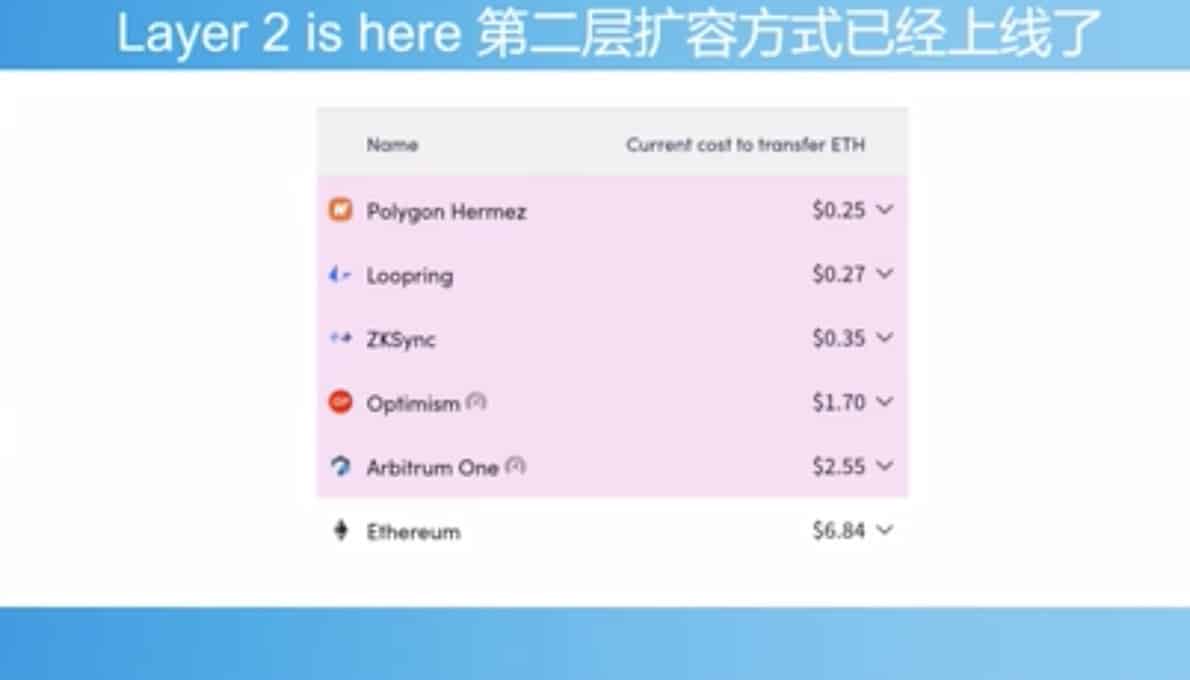Ethereum’s Ether, the second-largest cryptocurrency after Bitcoin, crossed the US$500 billion market cap mark for the first time this month, according to CoinGecko data. Amid the explosive growth of decentralized finance (DeFi) and non-fungible tokens (NFTs), scalability has been a key issue for Ethereum as the applications and number of users continue to grow.
Layer 2 is the future of Ethereum scaling and the only safe way to scale Ethereum while preserving decentralization that is so core to the blockchain, said Ethereum creator Vitalik Buterin in a speech today at the 2021 Shanghai International Blockchain Week.
The Eth2 roadmap offers scalability and the earlier phases of Eth2 are approaching quickly, but base layer scalability for applications is only coming as the last major phase of Eth2, which is still years away, Buterin said.
Work has been underway to make Ethereum more scalable, secure and sustainable with the Eth2 upgrades taking place progressively. The Beacon Chain upgrade, implemented in December, marked the first of the Eth2 upgrades and brought staking to the Ethereum ecosystem. “The Merge” — Ethereum mainnet’s merge with the Beacon Chain’s proof-of-stake system — will mark the end of a proof-of-work Ethereum and is scheduled to take place in 2022. Sharding, a multi-phase upgrade to improve Ethereum’s scalability and capacity through the use of shard chains to spread the network’s load across 64 new chains, is planned to follow in 2022, after The Merge.
Buterin acknowledged that there was an urgent need to make Ethereum more scalable but Ethereum native scaling (sharding execution) would take a long time. Rollups — a Layer 2 solution that handles transactions outside the main Ethereum chain (layer 1) but posts transaction data on layer 1 — had already been launched and could provide a significant increase in scalability up to a factor of 100.
Layer 2 solutions that have been launched include Polygon Hermez, Loopring, ZKSync, Optimism and Arbitrum One. The current cost to transfer ETH on Polygon Hermez is US$0.25 compared to US$6.84 for Ethereum, Buterin said.

See related article: Ethereum price touches new all-time high in altcoins rally
The Ethereum ecosystem is all-in on rollups as a scaling strategy for the near and mid-term future, said Buterin, adding that optimistic rollups, which are simpler and easier to build were likely to be preferred in the short-term.
In the long-term, however, ZK rollups, which were more complex but had strong security, were likely to be the preferred, Buterin said. ZK rollups — zero knowledge rollups that run computation off-chain and submit a validity proof to the chain — are much faster compared to optimistic rollups, which can take about a week for withdrawals.
Enterprise applications could also use ZK rollups — when the technology was ready — and enjoy low fees without the need to have a separate private blockchain, Buterin said.
See related article: Vitalik Buterin: Why Eth2 will propel Ethereum’s use in enterprise
Despite the progress in the technology and applications moving to rollups, a lot of work remains to be done. Buterin urged application developers to actively work on moving to rollups as quickly and safely as possible. Non-financial applications, in particular, could move to rollups to reduce fees as users were not willing to pay high fees for them. NFTs, Ethereum Name Service (ENS), light-clients, decentralized autonomous organizations (DAOs) could also move to rollups, Buterin said.
Ethereum virtual machine (EVM)-compatible rollups provide scale while preserving user experience, developer experience and decentralization, Buterin said. “Ethereum scaling is not just an idea, but a clear roadmap where many pieces of that roadmap have either been developed or already been released or are well in progress.”





